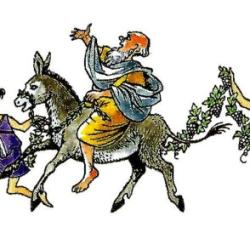The “evangelical left” of the late 20th century is having a bit of a moment thanks to Matthew Avery Sutton’s pot-stirring essay “Redefining the History and Historiography on American Evangelicalism in the Era of the Religious Right.” The existence then (and now) of a minority faction of “progressive” white evangelicals is getting more attention than usual thanks to folks pointing to it as an objection to Sutton’s contention that evangelicalism “is best defined” by its commitment to patriarchy, whiteness, and conservative politics.
Some of this attention is coming from a kind of knee-jerk, defensive hashtag-not-all argument that imagines the existence of Sojourners and the Chicago Declaration of 1973 somehow disproves Sutton’s point. That ignores how Sutton accounts for this himself in his essay (see again that grimly harsh-but-accurate “mostly failed” footnote). It also tends to confirm his overall argument, highlighting the paucity of counter-examples in a way that reinforces the accuracy of his overall description.
But there’s also a stronger, more level-headed variation of this #NotAll argument that seeks to qualify the unlovely implications of Sutton’s stark definition. Here’s a good example of that from historian Jake Randolph:
[Sutton is] right that as a prevailing coalition, postwar evangelicalism is “best defined as a white, patriarchal, nationalist religious movement” aligned with “conservative-leaning politics and free-market economics.” However, I want to recognize that evangelical identity is constantly being negotiated and challenged. David Swartz’s Moral Minority tells the story of the evangelical left at its peak in the 1970s. That collective largely dissipated, but other movements have emerged challenging the ubiquity of a GOP-driven, white, male evangelical category.
Much of Swartz’s history overlaps with my personal history. I wasn’t around for the “evangelical left at its peak” with the Chicago Declaration of 1973, but I’m the guy who literally typed the Chicago Declaration of 1993 at the same hotel 20 years later.* When these arguments point to “the evangelical left,” they’re pointing — in part — to me personally.
 That personal history is why I would, like Randolph, want to qualify and refine Sutton’s definition of evangelicalism. I don’t want to remove any part of what he says in his definition/description. My years spent as a card-carrying member (literally) made it abundantly clear that my status as an evangelical was contingent and contested in a way that the status of anyone who was “white, patriarchal, nationalist” and aligned with “conservative-leaning politics and free-market economics” was not and that this contingency and precarious status were due to precisely those defining aspects of evangelicalism.
That personal history is why I would, like Randolph, want to qualify and refine Sutton’s definition of evangelicalism. I don’t want to remove any part of what he says in his definition/description. My years spent as a card-carrying member (literally) made it abundantly clear that my status as an evangelical was contingent and contested in a way that the status of anyone who was “white, patriarchal, nationalist” and aligned with “conservative-leaning politics and free-market economics” was not and that this contingency and precarious status were due to precisely those defining aspects of evangelicalism.
But that wasn’t how anybody ever phrased it. What they said, rather, was that we “progressive evangelicals” were “unbiblical.” The Bible, they were somehow sure, was self-evidently white, patriarchal, nationalist, politically conservative, capitalist, etc., and anyone who wasn’t all of those things must not be reading the Bible or understanding it properly. And since they believed/asserted that the meaning of the Bible is obvious, apparent, and “perspicuous” to any well-meaning, spirit-filled reader, what they were not-so-subtly suggesting is that we were deceived or had hardened our hearts to its evident message of white, patriarchal, nationalist, etc.
This was frustrating for my mentors, the leaders of this “evangelical left.” Because these were excruciatingly biblical people.
Here’s what I want you to understand about the “evangelical left”: It was never completely “left.” But it was thoroughly, irreducibly, evangelical. The essence of its evangelical character was the essence of evangelicalism itself — its biblicism.
The evangelical left was also, and still is, very small. At Prism, the magazine for members of Ron Sider’s Evangelicals for Social Action, I tried to enroll us in a trade association for small religious magazines. We couldn’t do that. We were not big enough to qualify as a “small” magazine. We needed to triple our membership to get big enough to be small. (Dwight Ozard and I succeeded in doubling that membership, but that was the best we managed, so when I left Prism it was still smaller than small.)
Sojourners was, legitimately, big enough to be a small magazine. It was still not a big magazine, mind you, but it was way bigger than Prism. Yet while Sojourners is probably the flagship of the “evangelical left,” its readership was never mainly made up of evangelicals. More of its readers were mainline Protestants in sanctuary churches or blue-jean nuns — more of an Orbis Books crowd than an IVP/Eerdmans readership.
The way Jim Wallis described this to me was that “ESA is an evangelical organization working in the evangelical vineyard.” But Sojourners, he said, was “an evangelical organization working in other vineyards and other parts of the church.”
Ron Sider’s greatest contribution was the first edition of his book Rich Christians in an Age of Hunger. That book was, primarily, a Bible study. And it was a Bible study that employed the proof-texting, clobber-texting hermeneutic of white evangelicalism. Rich Christians is, in many ways, an archetypically evangelical work of concordance-ism — one that carries a particular power due to the sheer volume of its biblical citations.
Ron often referred to that massive body of scriptural citation as “the biblical data.” It’s hard to imagine a more white evangelical way of describing or approaching the Bible.
Jim Wallis, too, has always been thoroughly evangelical in his approach to the Bible. I never saw it, and I’m not 100% sure it literally exists, but there’s a famous story about Jim taking an exacto knife to a copy of the Bible and cutting out all of the passages on wealth and poverty and justice for the poor. The lacy, fragile remnants of the remaining book illustrated the same idea Ron was getting at in his talk of “the preponderance of the biblical data.”
“There are more than 2,000 verses in the Bible” about wealth and poverty, Wallis would often say. And if anyone seemed to doubt him about that, he’d start reciting them from memory. That is the white evangelical hermeneutic (or anti-hermeneutic). And that is why Ron Sider and Jim Wallis are quintessentially evangelicals.
You could argue that they are more “evangelical” than the conservative majority of evangelicals because they follow the logic of that hermeneutic more consistently, treating those thousands of biblical passages on wealth and poverty the same way their conservative counterparts treat the small handful of clobber-texts on women’s ministry or “homosexuality.”
Skip forward a generation to the still “mostly failed,” still not big enough to be small world of 21st-century “progressive evangelicalism” and consider someone like Shane Claibourne. Shane is an earnest activist — a pacifist with a passion for economic and restorative justice. He’s also a Bible-soaked, Bible-citing, thoroughly evangelical activist — a clobber-texter for the beloved community whose beliefs and arguments arise from that same white evangelical hermeneutic. If the “biblical data” about sexual morality is “perspicuous,” then so is the biblical data on violence.
This is where most “progressive evangelicals” come from. It is our origin story. We took what we were taught so seriously that we began to apply it to parts of the Bible that our teachers mostly ignored. This was just as true for me as it was for Ron, and Jim, and Shane.
But it wasn’t true for Tony Campolo. Because Tony Campolo is not really a white evangelical.
That’s not an attack, even if it uses the same words used by “conservative” white evangelicals to attack Tony Campolo over and over again for decades. Those attacks were because he was corrupting the youth with his “unbiblical” teaching. Back in the 1980s, those conservative defenders of “biblical” white evangelicalism sought to make an example out of him by holding a formal show trial accusing Tony of “heresy.” (This was mocked by the classic Wittenburg Door cover pictured above.) What was this allegedly “unbiblical” heresy that Tony was promoting? Well, it was precisely everything Matthew Avery Sutton describes in his definition of evangelicalism — it was all the stuff Tony preached that challenged evangelicalism’s mandatory “stances” in favor of white hegemony, patriarchy, conservative politics, laissez-faire capitalism, etc.
But the political and cultural boundaries acknowledged by Sutton — the political and cultural boundaries ferociously enforced by white evangelical gatekeepers themselves — are not what I’m talking about when I say that Tony Campolo is not really a white evangelical.
What I mean is that Tony Campolo is a missionary sent to white evangelicals. He was ordained as an associate pastor at Mount Carmel Baptist Church, a historic Black Baptist church in West Philadelphia. That’s where he was converted and discipled. And that is where he learned his hermeneutics — where he learned how to read and understand the Bible.
Mount Carmel is also where Tony learned to preach. The difference between Black church preaching and white evangelical preaching is “cultural,” but not in the reductive way that’s usually understood. The biggest “cultural” difference in those styles of preaching is hermeneutical — a very different way of reading and approaching and understanding and invoking the Bible. I’ve heard Tony preach more than 100 times and never once did I hear him attempt to quantify the preponderance of the biblical data.
So again, Tony Campolo is an indigenous missionary, a white guy commissioned by Black Christians to go and dwell among white evangelicals, preaching the gospel to us so that we might hear and repent and be saved.
How does that relate to Sutton’s essay?
Well, what seems most upsetting to his critics — folks like John Fea — is that they see Sutton as rejecting a theological definition of “evangelical” in favor of a political/cultural definition. But I think what Sutton is arguing, rather, is that white evangelical theology cannot be extricated from white evangelical culture. The one is the product of the other (and vice versa).
Here, again, is Jake Randolph, cycling around to this same point:
To think that we can define evangelicals by developing better theological rubrics or finding the perfect baseline doctrinal criteria is an exercise in missing the bigger point, which is what we’ve been talking about, that theology is never divorced from the other parts of our shared life–yes, politics and economics, but also the symbols, images, myths, assumptions about the world that we inherit and allow us to make meaning out of our reality.
However, if we want to home in on unique theological distinctives, I will say, I think the biblicist axiom of Bebbington’s model is the most theologically potent. …
Now, here’s where I would qualify Bebbington and tie it back to what I said above (and he may well agree with me): it is a mediated biblicism, which is to say, “what counts” as orthodoxy and orthopraxy is heavily influenced by oft-uninterrogated cultural scripts.
And an excellent description of those uninterrogated cultural scripts is Sutton’s litany: white, patriarchal, nationalist, etc.
Progressive evangelicals were able, somewhat, to apply their biblicism in ways that challenged those cultural scripts. But none of that was as inspiring as hearing someone preach from a tradition that had never been bound by those cultural scripts at all.
* I typed it, I didn’t write it. I was just taking dictation as fast as I could while Roberta Hestenes paced and preached in a Chicago hotel room at three in the morning. Gordon Aeschlimann and I made a few tweaks and suggestions and tightened it up a bit, but that document was 95% Roberta.

















